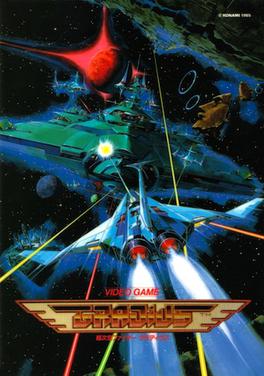
Gradius is a side-scrolling shooter video game developed and published by Konami. The first game in the Gradius series, it was originally released as a coin-operated arcade game in 1985. The player maneuvers a spacecraft known as the Vic Viper that must defend itself from the various alien enemies. The game uses a power-up system called the "power meter", based upon collecting capsules to purchase additional weapons.

R-Type is a horizontally scrolling shooter arcade video game developed and released by Irem in 1987 and the first game in the R-Type series. The player controls a star ship, the R-9 "Arrowhead", in its efforts to destroy the Bydo, a powerful alien race bent on wiping out all of mankind. The R-9 can acquire a glowing orbicular device called a "Force", protecting it from enemy fire and providing additional firepower. The arcade version was distributed by Nintendo in North America; it is the last arcade title Nintendo distributed.
Shoot 'em ups are a sub-genre of action games. There is no consensus as to which design elements compose a shoot 'em up; some restrict the definition to games featuring spacecraft and certain types of character movement, while others allow a broader definition including characters on foot and a variety of perspectives.

Contra is a 1987 run and gun video game developed and published by Konami for arcades. A home version was released for the Nintendo Entertainment System in 1988, along with ports for various home computer formats, including the MSX2. The arcade and computer versions were localized as Gryzor in Europe, and the NES version as Probotector in PAL regions and France.

Ikari Warriors, known as Ikari in Japan, is a vertically scrolling run and gun video game released for arcades by SNK in 1986. It was published in North America by Tradewest. At the time there were many Commando clones on the market. What distinguished Ikari Warriors were rotary joysticks and a two-player cooperative mode. The rotary joystick controls were in turn based on SNK's earlier TNK III (1985). Ikari was originally intended to be an official licensed adaptation of the film Rambo: First Blood Part II (1985), but SNK were initially unable to acquire the rights to the film.
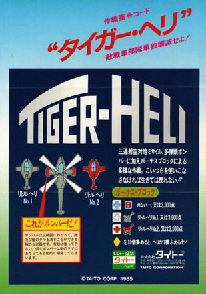
Tiger-Heli is a vertically scrolling shooter game developed by Toaplan and released for arcades in 1985. It was published in Japan by Taito and in North America by Romstar. Controlling the titular attack helicopter, the player must fight endless waves of military vehicles while avoiding collision with their projectiles and other obstacles. The Tiger-Heli has a powerful bomb at its disposal that can clear the screen of enemies when fired. It was the first shoot 'em up game from Toaplan, and their third video game overall.

1943: The Battle of Midway is a 1987 vertically scrolling shooter arcade video game developed and published by Capcom.
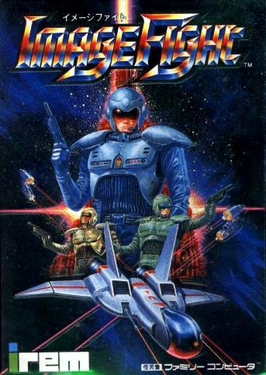
Image Fight is a 1988 vertically scrolling shooter arcade video game developed and published by Irem. It was ported to the Nintendo Entertainment System, PC Engine, Sharp X68000 and FM Towns in 1990. The NES version was the only version that was released in North America. It was followed by Image Fight II: Operation Deepstriker.

P.O.W.: Prisoners of War, released in Japan as Datsugoku -Prisoners of War-, is a side-scrolling beat 'em up game produced by SNK and originally released as an arcade game in 1988.

U.N. Squadron is a 1989 side-scrolling shooting game released by Capcom for the CPS arcade hardware and for the Super Nintendo Entertainment System. The game was released in Japan as Area 88, and is based on the manga series of the same name, featuring the same main characters. Their mission is to stop a terrorist group known as Project 4. It was followed by a spiritual successor Carrier Air Wing.

Jackal, also distributed under the title of Top Gunner, is an overhead run and gun video game released for arcades by Konami in 1986. The player must maneuver an armed jeep in order to rescue prisoners of war (POWs) trapped in enemy territory.

Trojan is a side-scrolling action game developed by Capcom, originally released as a coin-operated arcade video game in 1986, and published in North America by Romstar and Capcom. Directed by Takashi Nishiyama, the game includes beat 'em up and hack-and-slash elements. It is a spiritual successor to the beat 'em up Kung-Fu Master (1984), which was designed by Nishiyama at Irem before he left for Capcom, where he evolved its gameplay concepts with Trojan. It is also considered a spiritual successor to Capcom's Ghosts 'n Goblins (1985), which has similar side-scrolling action gameplay elements.

Galaga '88 is a 1987 fixed shooter arcade video game developed and published in Japan by Namco and in North America and Europe by Atari Games. It is the third sequel to Galaxian. It features significantly improved graphics over the previous games in the series, including detailed backgrounds, larger enemies and greater ship details. The game runs on Namco System 1 hardware.
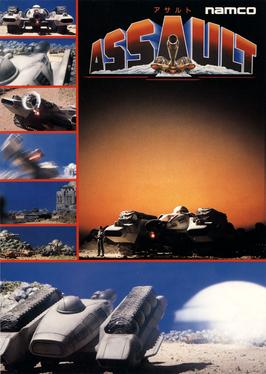
Assault is a 1988 multi-directional shooter arcade game developed and published by Namco. It was licensed to Atari Games for release in North America. Controlling a caterpillar-tread self-propelled gun, the player is tasked with completing each of the game's eleven stages while shooting enemies and avoiding projectiles. It uses a twin-stick control layout, similar to games such as Battlezone. The plot involves the human race searching for new planets after Earth reaches its maximum population - after discovering an exo-planet 35,000 light years away from the Milky Way, they enslave the planet's natives and take control, leading to the planet's native population vowing to abolish the humans and bring peace to their world. The protagonist who rides the aforementioned self-propelled gun which players control, is one such native.

Dragon Spirit is a 1987 vertical-scrolling shooter arcade game developed and published by Namco. In North America, it was distributed by Atari Games. Controlling the dragon Amur, the player must complete each of the game's nine areas to rescue the princess Alicia from the demon Zawell. Similar to Namco's own Xevious, Amur has a projectile weapon for destroying air-based enemies and a bomb for destroying ground enemies. It ran on the Namco System 1 arcade board.

Salamander 2 is a 1996 horizontally scrolling shooter arcade video game developed and published in Japan by Konami. It is the direct sequel to Salamander (1986) and the third game in the Salamander series, which itself is a spin-off of the Gradius franchise. Up to two players control two starships — the Vic Viper and the Super Cobra — as they must destroy the alien race Doom before they wipe out all of the planet Gradius. Gameplay involves shooting down enemies, collecting power-up items, and avoiding collision with projectiles or obstacles.
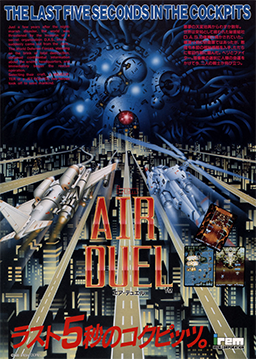
Air Duel is a vertically scrolling shooter game released for arcades by Irem in 1990. It was followed by an unofficial sequel called Air Assault in the west and Fire Barrel (ファイアーバレル) in Japan.

A-Jax (エー・ジャックス) is a vertically scrolling shooter released in arcades by Konami in December 1987. There was a European release of the game called Typhoon, which is the name used for Imagine Software's ZX Spectrum, Amstrad CPC, and Commodore 64 ports.

B-Wings is a vertically scrolling shooter first released as an arcade video game by Data East in 1984. A version was released in 1986 for the Family Computer. It was Data East's first home release for the console. The Family Computer version is notable for its inclusion in many unofficial Famiclone multicarts.

Section Z is a horizontally scrolling shooter by Capcom, released as an arcade video game in 1985. A home version was published for the Nintendo Entertainment System in 1987.


















